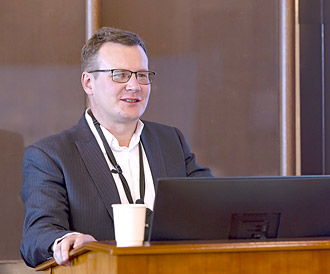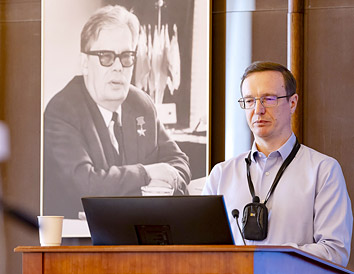
Electronic english version since 2022 |
The newspaper was founded in November 1957
| |
At PAC meetings
Discussions were productive
The results of the 59th meeting of the Programme Advisory Committee for Condensed Matter Physics, held on 24-25 June, are summed up by PAC Chairman Denes Nagy.
The first report of the meeting by Egor Lychagin was dedicated to the current state of work on the project of a new neutron source. How does the Committee estimate the state of things?
- The PAC recommended further work on the project to develop a new neutron source. The Program Committee agreed with the proposal of FLNP Directorate that at the current stage of work, activities should be focused on the following issues: development of the concept of a new source; development of mathematical models that describe the processes resulting in pulse energy fluctuations, based on the operating experience of IBR-2; further work on the development of a scientific programme for a new reactor with an instrumentation concept; further work on developing the concept of a system for quick change of working material in the cryogenic moderator chamber of the reactor, as well as expansion of work to determine the optimal configuration of the cryogenic moderator chamber of a new neutron source with a working substance based on hydrogen-containing materials. So, in whole, the PAC's estimation was favorable.
After this report and the report on the resumption of the operation of IBR-2 and the user programme, a separate discussion was to be made. Did it help in developing the final recommendations?
- It was just a way to discuss thoroughly the details of the speeches of Egor Lychagin and Bagdaulet Mukhametula. Indeed, in this discussion we briefly spoke about the reports on the new JINR neutron source and plans to resume operation of the IBR-2 reactor, as well as to restart the user programme. The reason for raising this question was the need to involve members of the PAC in a lively discussion of these tasks. In previous meetings, we did not have enough Programme Committee members to exchange views, to give possible advice and the like. Time was allocated for discussion of these issues immediately after the end of the reports. Members of FLNP Directorate, as well as JINR, emphasized that they would highly value the opinions expressed on these issues. However, all of the points made by PAC members during this short discussion have already been made before.
Two more reports were dedicated to the modernization of the reactor spectrometer fleet. Again IBR-2 and its instruments became the central topic of the meeting. Is it dictated by the concern of PAC experts about the future neutron source?
- In two excellent reports, Viktor Bodnarchuk and Evgeny Lukin reported on the state and progress of modernization of instruments at the IBR-2 reactor and on the current state of the DN-6 diffractometer for studying materials at ultra-high pressures, respectively. It has almost nothing to do with the future source of JINR neutrons and one can hardly speak of any concern among PAC experts about this matter. Among other things, Viktor Bodnarchuk showed how the new SANSARA instrument on IBR-2 is designed to lighten the current heavy load on the YuMO small-angle scattering spectrometer. At the PAC meeting, an issue as the number of reviewers in various expert groups of the user programme was also discussed. Of course, restoring the user programme in 2025 will require a concerted effort from all the parties involved.


Evgeny Lukin and Viktor Bodnarchuk
The reports on the projects were dedicated to biological topics. How did the experts estimate them?
- Alexander Nechaev and Mikhail Zarubin reported on highly sensitive sensors based on molecular recognition for detecting viruses and on the status of the project "Protection from physical and chemical stress using tardigrade proteins" (ТАRDISS), respectively. The PAC recommended opening a new project "Highly sensitive sensors based on molecular recognition for detecting viruses" for its implementation in 2025-2029 within the framework of the topic "Radiation materials science, nanotechnology and biomedical research using heavy ion beams". The PAC welcomed the investigation of the molecular mechanisms of multiple stress resistance of extremophiles that becomes possible due to the advent of omics technologies. The Molecular and Cellular Genetics Sector of DLNP studies the properties, molecular structure and prospects for practical application of the radioprotective protein Dsup of tardigrades (damage suppressor). In joint experiments with FLNP to determine the structure and properties of the protein, the authors of the project showed that Dsup is an internally disordered protein that develops a highly dynamic complex with DNA and is itself resistant to radiation degradation. Based on the new data, a composite biomaterial was produced jointly with the FLNR Centre for Applied Physics. It is a track membrane functionalized with the Dsup protein for selective cell-free DNA extraction from solutions. The PAC welcomed the ongoing activities within the TARDISS project and recommended further prolongation of the project within the topic "Investigation of molecular genetic mechanisms of adaptation of extremophilic organisms". The expert estimations of both project reports were very positive and the PAC completely supported their position.
The programme of this meeting included traditional scientific reports and posters by young scientists. Were they made to a traditionally high standard?
- 19 virtual posters participated and were presented in Zoom session rooms (both in-person and remote participants). Most of the reports was provided by FLNP and FLNR, and several - by LRB. Typically, posters should be about six slides long so they can be presented in about five minutes. The vast majority of participants fell within this framework and visitors that followed the course of the discussion became participants in interesting and exciting discussions. As a deterrent counterexample, I will give one of the virtual posters that consisted of 19 slides and accordingly, this speaker had no chance of being estimated at all. However, most of the entries were done to a very high standard and choosing the best three posters proved a difficult task. As always, this was done by secret ballot, professionally organized and implemented by the Scientific Secretary of the PAC Oleg Belov, whom I would like to thank for his participation and hard work. I think the current technique of virtual poster presentations should be maintained when, hopefully soon, we return to in-person meetings. The time of printed posters in A0 format is over and gone forever.
Your impressions of the PAC meeting, of the meeting of its participants with JINR Directorate and the discussions.
- The meeting and its discussions were indeed very productive. I would like to note the active participation of JINR Director Grigory Trubnikov throughout the entire programme of the first day. Unfortunately, he was unable to take part in the closed meeting of the PAC members with JINR Directorate where nevertheless, a fascinating discussion began that ended after 30 minutes.
Olga TARANTINA,
photo by Elena PUZYNINA